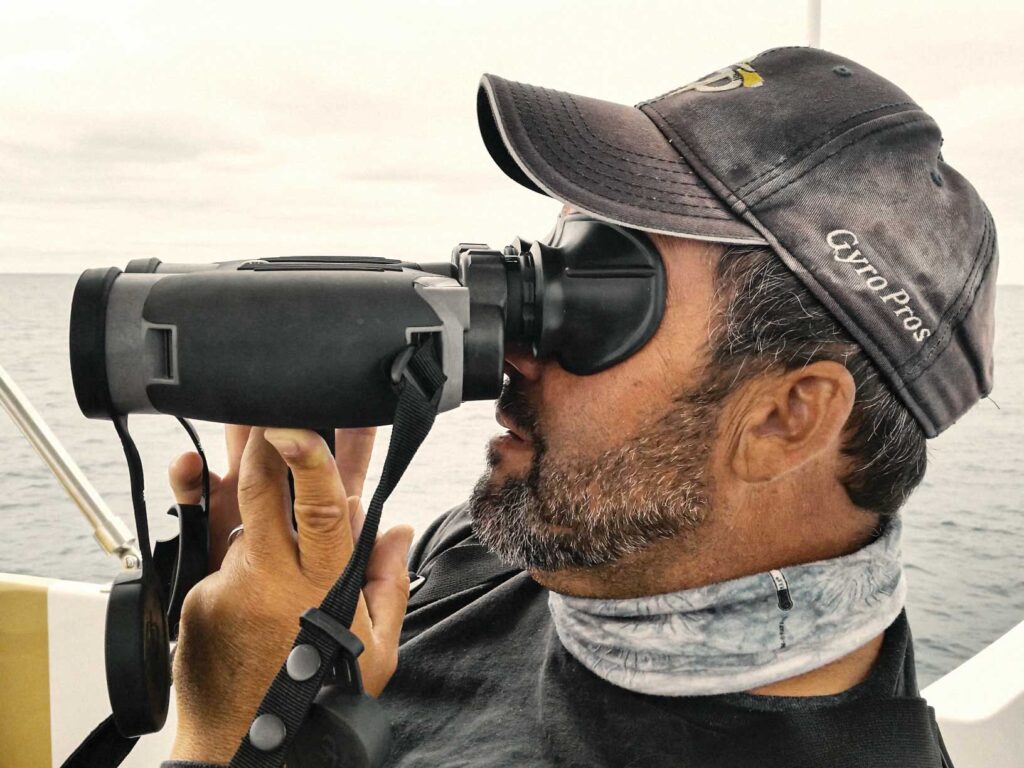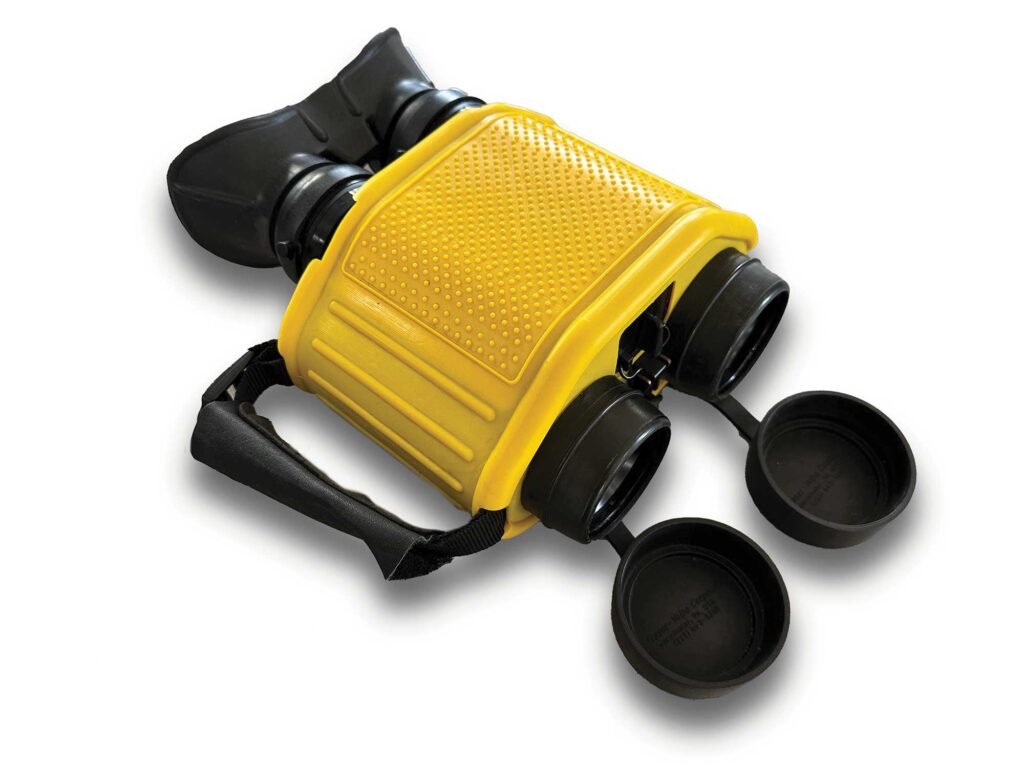
Standing in a swaying tuna tower while trolling for mahi off Southern California, I scanned for any sign of life in the blue waters ahead using conventional 7×50 marine binoculars, but saw nothing.
At the same time, Capt. Barry Brightenburg, who stood beside me in the tower with his eyes locked into gyrostabilized binoculars, saw what I could not perceive. A pair of tiny white terns fluttered over a small patch of kelp nearly 2 miles away. Without removing the gyros from his eyes, Brightenburg gave me a vector to steer. As we closed this distance, the ocean exploded with life. We had found the mahi we came to catch.
Steady View
This is the magic of gyroscopic-stabilized binoculars. The electrically powered gyro technology smooths out the bumps of rough seas to create a steady field of vision, allowing for greater magnification than traditional binocs. Most conventional marine binocs max out at seven times (7x) magnification because anything greater becomes too jittery to be useful in rough seas. But the stability of gyro binocs allows for doubling that number, boosting the magnification to 14x or even 16x.
Jimmy Kingsmill, a veteran angler from California, along with a handful of other angling legends, pioneered the use of these optics three decades ago. Today, Kingsmill fishes around the world and is the distributor of one of the most popular brands of gyro binocs—Fraser Optics. Fraser’s S250 14×41 gyro binocs retail for about $5,000, while its M25E 14×40 gyro binocs retail for $3,600. The other leading brand in this field is Fujinon, and its Stabiscope 12×40 gyro binocs sell for around $5,000, while the 16×40 version retails for about $5,500.
Price-Worthy?
Such advanced technology creates two conundrums. For one, as outlined above, high tech carries a high price. Secondly, after experiencing the benefits of technology, you can’t imagine life without it. Both axioms hold true when it comes to handheld gyroscopic-stabilized binoculars for fishing.
“Once you have them, you can’t do without them,” Kingsmill says. “I can see a frigate bird or a single jumping spinner dolphin (a sign of tuna in Pacific tropics) up to 8 miles away.” Derived from military technology, the key to these optic systems is the battery-powered gyrostabilization system that prevents the image from bouncing about in bumpy seas. The handmade Fraser gyro, for example, spins a brass ring at 1,200 rpm to hold the binocs steady.
Early Origins
Gyros first made their mark in the Southern California marlin tournament scene, where the fishing technique often calls for finding the slender upper lobe of a striped marlin tail as the fish swims at the surface. Anglers search intently with binocs, and once a marlin is located, they close the distance and cast live baits such as mackerel to the fish.
Gyro binocs changed the game, allowing anglers to find even the faintest trace of a tailing marlin at previously unheard-of distances—up to 3 miles away. As a result, in order to be competitive, every team entered in a marlin tournament from SoCal to Cabo has at least one pair of gyro binocs on board today.
Read Next: Are Gyro-Stabilized Binoculars Worth the Money?

Guide the Way
Many boats have one or more crewmembers with multiple gyros—Kingsmill calls them “gyro pilots”—dedicated to scouting the waters for the tails of striped marlin. Gyro pilots often perch in the flying bridge or tuna tower to extend their view over the horizon even farther. They use beanbag chairs and pillows to recline and brace themselves, supporting their arms and forestalling fatigue.
Even after gyro pilots locate signs of fish, they remain fixed on the target through the optics, verbally updating the position and distance to the fish as the helmsman drives the boat in response to commands, such as, “2 o’clock, 1 mile.”
Expanded Use
Today, the utility of gyro binocs extends well beyond striped marlin fishing. Increasingly, anglers use this optical electronic technology to find birds such as frigates, terns, shearwaters and gannets; scout for weed lines, kelp paddies and other floating objects that attract offshore fish; find flagging swordfish; and search for schools of breaking fish.
The technology is also spreading beyond the West Coast, Kingsmill says. “Captains and boat crew who venture to fish the Pacific coasts of Costa Rica and Panama have witnessed the effectiveness of gyro pilots in finding fish,” he explains. “These anglers then often bring that experience back to places like Florida, the Gulf Coast or the Northeast, and start using gyros in their home waters.”
Clear the Deck
“When using the binos, the best technique is to search with the sun at your back and in a following sea,” says Brightenburg, who uses Frasers extensively while fishing offshore in waters off Southern California for species such as bluefin tuna and mahi. “Also, if there are other boats in the area, drive away from that area and head out to find fish by yourself far away from the crowd.
“I like to eliminate any visual obstructions on the bow such as rods in vertical rod holders,” Brightenburg adds. “Ultimately, I could not do my job without the gyros.”
Gyroscopic-stabilized binoculars, combined with an elevated position in a tower or flybridge and the dedication to continually keep the binocs to your eyes for hours, can help catch more offshore fish than without this technology, one that merges electronics and optics. Pricey, yes. Are they worth buying? To the anglers who use them effectively, the answer is an unmitigated yes.









